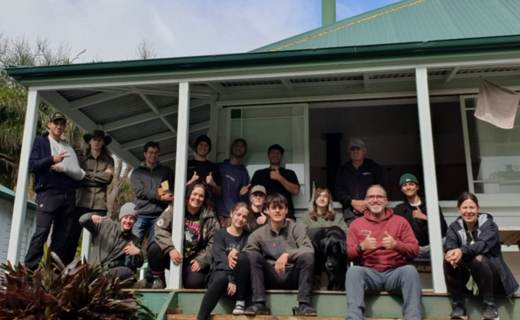Trainee Conservation Rangers Put Skills to the Test

Monday, 14 Oct 2024
Fifteen dedicated trainee conservation rangers put five months of work to good use on a recent 10-day training excursion on Great Barrier Island.
During their time at Aotea, the Toi Ohomai Institute of Technology ākonga completed essential conservation tasks, including track maintenance, environmental restoration and pest control, honing the skills they've learnt over the past five months.
Students undertook significant volunteer projects at Glenfern Sanctuary, a sprawling 300-hectare conservation reserve, to ensure the sanctuary was ready for an influx of visitors over the summer tourism season.
Academic Staff Member - Conservation Operations, Ron Lidgard, says the excursion offered an immersive and hands-on conservation experience for ākonga, contributing to both positive ecological outcomes for the reserve, and personal development for the students who took part.
"The students contributed to building, infrastructure and conservation projects underway at the sanctuary. One of the key achievements was the clearance of 70 trap lines, which will significantly contribute to predator control on the peninsula.
"Ākonga conducted comprehensive rate tracking index monitoring, and more than 1,800 traps were rebaited across 240 hectares of the conservation reserve. This work is vital to maintain Glenfern Sanctuary's status as a predator-free environment, and to protect vulnerable native species," says Ron.
This is the fifth year Toi Ohomai conservation trainee rangers have completed conservation work on Great Barrier Island. They gain credits for the practical tasks they complete, which go towards achieving their Certificate in Conservation (Operations) qualification.
This year's ākonga had the rare opportunity of interacting closely with endangered fauna, including encounters with the chevron skink, orange-fronted parakeet and little blue penguins, Ron says.
"This highlighted the Glenfern Sanctuary's bio-diversity and the importance of ongoing conservation efforts. Seeing native birds like the kaka each day also reinforced the richness of the local ecosystem."
Students also met with local iwi, and representatives from Auckland Council, Tu Mai Taonga, and Envirokiwi, demonstrating the collaborative nature of conservation on Aotea.
"The involvement of multiple stakeholders reflects the wider community's commitment to ecological preservation, the value of partnership in achieving positive conservation outcomes, and Glenfern Sanctuary's broad management requirements.
"To cap off a successful 10 days on Great Barrier Island, the group was invited to a dinner and the students' hard mahi was recognised, as well as the impressive outcomes they achieved during their time at Aotea," Ron says.
More than 70% of Certificate in Conservation graduates go on to careers in the conservation industry, many choosing to work at the Department of Conservation.
Ron says conservation excursions, such as this one to Glenfern Sanctuary, provide ākonga with a practical understanding of what it's like to work in conservation day-to-day in Aotearoa.
"They experience everything from working in remote areas with pristine landscapes, to the physical tasks involved like clearing debris after storms, and building tracks and stairs. Access to power and internet is limited, but conservation rangers work in some of the most amazing parts of New Zealand and make a real difference."
